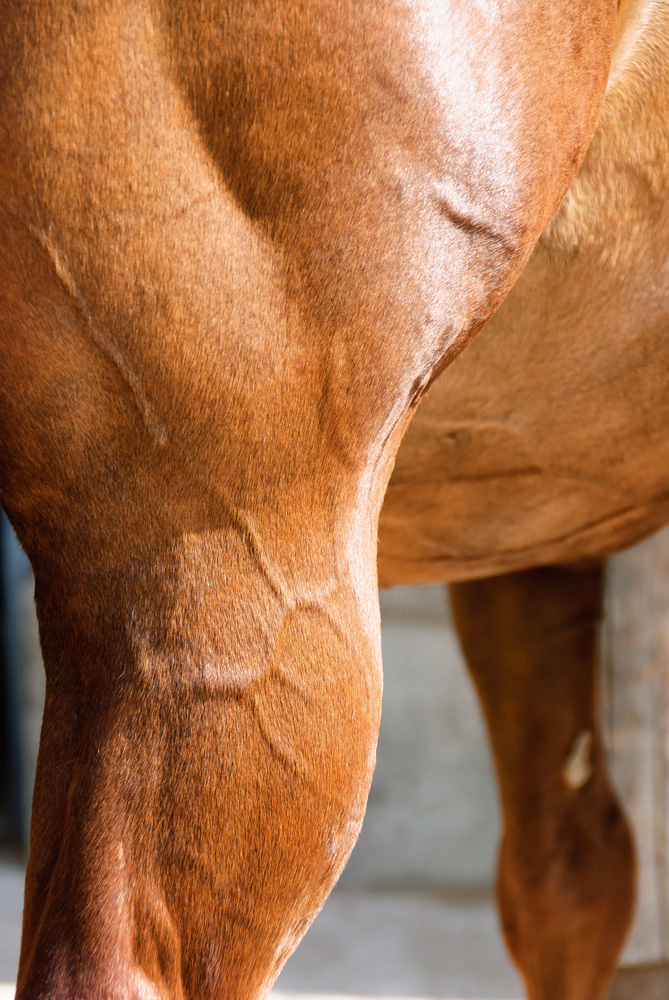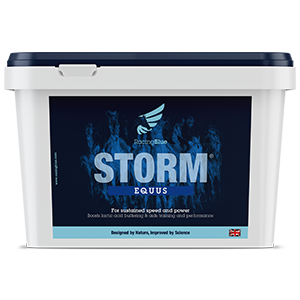The Critical Role of Nutrition in Tying Up (rhabdomyolysis)?
Date: 15 April, 2016

A horse with raised muscle enzymes is always a cause for concern for riders and trainers, whether it is a single isolated incident or a regular occurrence. The muscle enzymes (aspartate aminotransferase, AST and creatine phosphokinase, CPK) when present at a high level in blood usually indicates muscle damage. This may simply be a result of overexertion during training, but can signify a more serious issue in the form of exertional rhabdomyolysis (ER) or ‘tying up’. These horses, which are quite often fillies or mares, can be notoriously difficult to train and compete with many lost training days resulting in a decreased opportunity to race or compete.
There has been a slow but steady increase in our knowledge of this disease or syndrome, which in more recent years has been helped by the application of genetic based tests for some forms. An increase in our understanding of the metabolic basis for the syndrome is imperative and will help us to better manage these horses in terms of nutrition and training.
Characteristics of ER Syndrome
ER is a metabolic disorder involving the muscles, which is characterised by some of the following clinical signs: sweating, a raised respiratory rate, stiffness of gait and or a reluctance or inability to move, hard and painful muscle groups usually but not limited to the quarters. In severe cases the urine may be discoloured or reddened due to the excretion of myoglobin (the oxygen carrying pigment in muscle). It is this myoglobinuria, which is of greatest clinical risk, as it can precipitate kidney damage and even death. One of the most commonly noted signs of ER is muscle damage, as evidenced by the ‘leakage’ of the two muscle enzymes AST and CPK into blood.
Classification
ER is not a single disease, but a syndrome consisting of different sub types with some common clinical signs. ER can be described as sporadic, where episodes are isolated or infrequent, or chronic where horses have repeated episodes nearly always accompanied by a raised muscle enzyme concentration in blood.
- Sporadic rhabdomyolysis – this is the term used describe occurrences of muscle damage in horses where there is no prolonged previous history of ER. These cases can often by explained by muscle strain due to over-exertion or over training and sub-optimal dietary intake of electrolytes, vitamin E and or selenium sometimes become apparent. In addition, it is not unusual for individual horses to exhibit sporadic ER where a viral challenge such as influenza or herpes virus is present.
- Chronic rhabdomyolysis is characterised by a genetic metabolic defect that leads to two quite different forms of ER namely polysaccharide storage myopathy (PSSM), which is primarily found in quarter horses, warmbloods and draft breeds. In Thoroughbreds in race training, the more prevalent chronic form of ER is known as recurrent exertional rhabdomyolysis (RER).
In Thoroughbred race training, when presented with a horse with raised muscle enzymes in blood we are likely to be dealing with either sporadic ER or recurrent ER and it is upon these two sub types that this article will now focus. The prevalence of ER in horses in race training in the UK has been reported to be about 7%, with 80% of trainers stating that they had at least one horse within the yard with ER. Within this group of horses, the chance of more than one episode of ER occurring was high 74% and the average number of training days lost was 6 days.
Progress has been made in recent years in understanding the genetic basis and metabolic defect involved in chronic ER. Studies have suggested that this form of ER is associated with abnormal calcium regulation within muscle cells. Calcium is intimately involved in muscle contraction and each time a muscle contracts, calcium is released from a structure called the sarcoplasmic reticulum, a calcium storage site within the muscle. The calcium is then slowly taken back up and re stored within the sarcoplasmic reticulum in muscle in order for the muscle to relax. Horses with ER show increased leaking of calcium ions via calcium channels from the sarcoplasmic reticulum and Dantrolene, a medication used to treat tying up, can reduce this leakiness.
It should be made clear, however, that this mechanism is unconnected to dietary calcium intake, which hitherto has not been shown to modify this process.
Interestingly, carnosine a small protein found in muscle that works to stabilise muscle acidity also acts as an intramuscular antioxidant and is known to improve the sensitivity of the muscle contraction apparatus to calcium. STORM® by Racing Blue provides crucial nutritional building blocks to boost the carnosine content of muscle.
Genetics
Data from breeding trials and pedigree studies in the US propose that chronic ER is almost certainly genetic in basis and is inherited on a non-sex linked basis in a dominant fashion. This effectively means that chronic ER can be passed on by sire or dam and animals can have either a single or two copies of the defective gene, but all will be susceptible to the disease in association with certain trigger factors. A sobering thought is that in the case of the horse with two copies of the defective gene, the genetic predisposition will always be passed onto their offspring. However, in the horse with a single copy of the affected gene there is a 50% chance that this will not be passed on, assuming the mate (sire or dam) is unaffected. Despite carrying the defective gene, however, horses will only express that abnormal gene and show signs of ER in certain conditions, which can be related to trigger factors such as diet, excitability, stress and exercise regime.
Unfortunately, there is not a simple genetic diagnostic test for chronic RER, however, with the advent of the sequenced equine genome and many studies on-going in this area, we may not have to wait long. A new and exiting area of nutritional research known as nutrigenomics can also be used to investigate the effect of diet or particular individual nutrients on expression of genes and hence the development of disease. Chronic ER may be an area of interest in this respect.
Diet and management
Although the causes of both the sporadic and chronic forms of ER are not fully understood, a number of dietary and other management risk factors have been implicated, these include:
- Energy intake – associated with high-energy intake.
- Source of energy – associated with high NSC intake (starch and soluble sugar) intake.
- Inadequate or unbalanced macro minerals in the diet, particularly calcium, phosphorus and magnesium.
- Insufficient electrolyte supply to replenish losses in sweat – sodium, chloride and potassium.
- Inadequate or sub optimal antioxidant provision – particularly selenium and vitamin E.
- Stress and excitable behaviour.
- Level of work and training characteristics.
- Age and sex, younger animals being at greater risk with fillies particularly being at a high risk.
More recently it has been proposed that stress, nervousness and excitability are key factors in triggering an ER attack in affected individuals and so feeding and management strategies now often target behaviour.
Practical feeding strategies for ERS
Pasture & other forage
Pasture intake also needs to be managed carefully as grass can be a significant source of water soluble carbohydrates as part of the non starch carbohydrate fraction (NSC), much of this being made up by sucrose sugar and fructan. The NSC content of grass is also highly variable and so the best practical advice is to be careful during periods where grass growth is increased and treat the horse as if it were a laminitis animal monitoring and carefully controlling grass intake.
For horses with ER, adequate quality forage is essential. This is because good forage, fed at a generous level, will contribute a greater amount of energy per day in the form of fibre. This in turn reduces the requirement for concentrate feed. Multiple forms of forage such as hay, haylage and alfalfa can also help to improve forage intake, although an excess of alfalfa should be avoided. Typically, a minimum of 1.5% of bodyweight in the form of hay or haylage on a dry matter basis should be consumed. The soluble carbohydrate content of all forage needs to be considered and this will be dependent on the type of grasses and stage of growth of harvesting. The NSC content of hay can be reduced through a process of soaking for 30 minutes, which will leach out some of the sugars, although advice should be sought as soaking can also leach out important minerals.
Concentrate feed
Concentrate feed should provide sufficient energy for the work undertaken, and the main source of that energy should be digestible fibre and oil. Additionally, the starch content of the ration (i.e. cereals) should be minimised. Typically such concentrate feeds should have a starch content below 15%, with oil being present between 6-14%. A feed and or balancer product should be chosen that allows the horse to be fed at least at a level of intake that conforms to the manufacturers recommended intake. This ensures an adequate delivery of vitamins and minerals.
There are a number of suitable commercial feeds of this type available, but practically palatability can be a problem, particularly when the oil content is very high, especially in horses in full work. Meals should be small and fed on a regular basis. The addition of soaked unmolassed sugar beet with feed can also help to improve palatability when fed together with concentrate feeds. Addition of oats to the feed is not advised, due to their relative high starch content. The thinking behind this type of diet is to reduce excitability and promote calmness. It has been demonstrated that horses with a susceptibility to RER fed a high concentrate intake, are less excitability and exhibit lower post exercise blood CK levels when fed a low starch, high fibre high oil ration compared to those same horses when fed a high starch, low oil, low fibre feed. In horses that struggle to maintain condition, high oil ingredients such as straight vegetable oil, micronized linseed or rice bran can be useful for topdressing. Vegetable oil obviously has a zero starch content, whilst that of micronized linseed and rice bran is typically about 5 and 14% respectively, but can vary between sources.
Whilst total energy intake and energy source appear to be the most important dietary factors with respect to ER, attention to the provision of antioxidants, mineral balance and electrolytes is also warranted, especially to minimise the risk of sporadic ER. In addition, ingredients that promote calmness and reduce excitability are also worth investigating.
Antioxidants
Antioxidant deficiency is not thought to contribute to ER, but antioxidant requirement may be higher due to the process involved in on-going muscle damage. A well-balanced diet will provide an adequate intake of the main antioxidant co-factors copper, zinc, manganese and selenium, but additional vitamin E may be required depending on the concentrate product used. For horses in race and competition training, total vitamin E intake has been advocated at 1600 – 2500IU / horse / day. There is also some rational for ensuring that selenium is provided in an organic form and that a natural form of vitamin E is used, as both are believed to be more available than conventional sources of these antioxidants.
Mineral balance
The calcium content of the diet does not directly effect calcium regulation within muscle, with respect to chronic ER. However, inadequate intake or an imbalance in the ratio of calcium to phosphorus has been shown to be significant in some cases of ER particularly the sporadic subtype. Careful attention is needed to maintain an adequate intake of both calcium and phosphorus and to ensure a suitable ratio between these two minerals (2:1) in the total diet. Adequate intake of magnesium is also likely to be important, especially as anecdotally magnesium supplementation has been suggested to moderate excitable behaviour, although further controlled scientific studies are needed to support this premise.
Electrolytes
Horses lose a large amount of electrolyte in sweat and the losses may be heightened where sweat rate is increased e.g. in hot weather or in anxious or excitable horses. The major electrolytes lost in sweat are sodium, potassium, chloride, calcium and magnesium. Generally speaking the losses with respect to potassium, chloride, calcium and magnesium are replenished easily by the forage and concentrate feeds. However, in my experience sodium is often present at sub-optimal levels in race and competition diets. Even where salt is provided as an additional source of sodium, the level of intake can be inadequate. Whilst salt intake should be adjusted according to work rate, weather and individual sweating rates, in general terms 25-50g per day is sometimes warranted. This quantity of salt fed should not be added to a single feed but split between 2 or 3 feeds during the day. Your veterinarian may advocate the use of a test known as a creatinine clearance test which takes a paired blood and urine sample and estimates the true individual requirement for macro minerals and electrolytes based on the blood level and losses in the urine.
Calmers
This is a potentially interesting area of management for horses predisposed to ER, but one which has received very little attention scientifically, either in normal horses or those with ER. A single trial has suggested that diets supplemented with about 500g of soy-lecithin can reduce excitable behaviour, measured as spontaneous movement and reactivity, in horses. Other ingredients that have been anecdotally suggested to promote calmness include magnesium, chromium yeast, tryptophan, valerian and GABA, although currently the science is simply not there in horses to support these assertions. In addition many of these ingredients e.g. valerian and GABA would be regarded as prohibited substances for racing and competition.
Management
Certainly with respect to chronic ER, management strategies aim to reduce stress and excitability and this encompasses both aspects of feeding and training. Recommendations include that horses with ER should not be fed more feed in anticipation of exercise and feed intake should always be reduced on rest days, or periods of reduced work. Feed quantity needs to be tailored to maintain good body condition, without promoting excess weight gain. Feed also needs to be provided on a little and often basis and there is some merit in ensuring these horses are fed first to avoid undue anxiety. If there is the opportunity for turnout at grass and this does not result in separation anxiety then this can also be beneficial. Other management factors such as stabling these horses in a quiet part of the yard and allowing them to be exercised first rather than last are also advocated. Avoiding rest days and ensuring that re- introduction to work is gradual following essential rest days is also important. There is also some belief that these horses should not be held back, as far as practical during fast work, as this can lead to excitability and stress.
Exertional rhabdomyolysis is a complicated syndrome and its associated symptoms are not always nutritional in origin, but despite this, a well-balanced and appropriate diet can often aid conventional veterinary therapy in some individuals. It is likely that the trigger factors for ER episodes are different between individuals and so it is not surprising that there is variability in the success of the management of this condition through dietary means.

